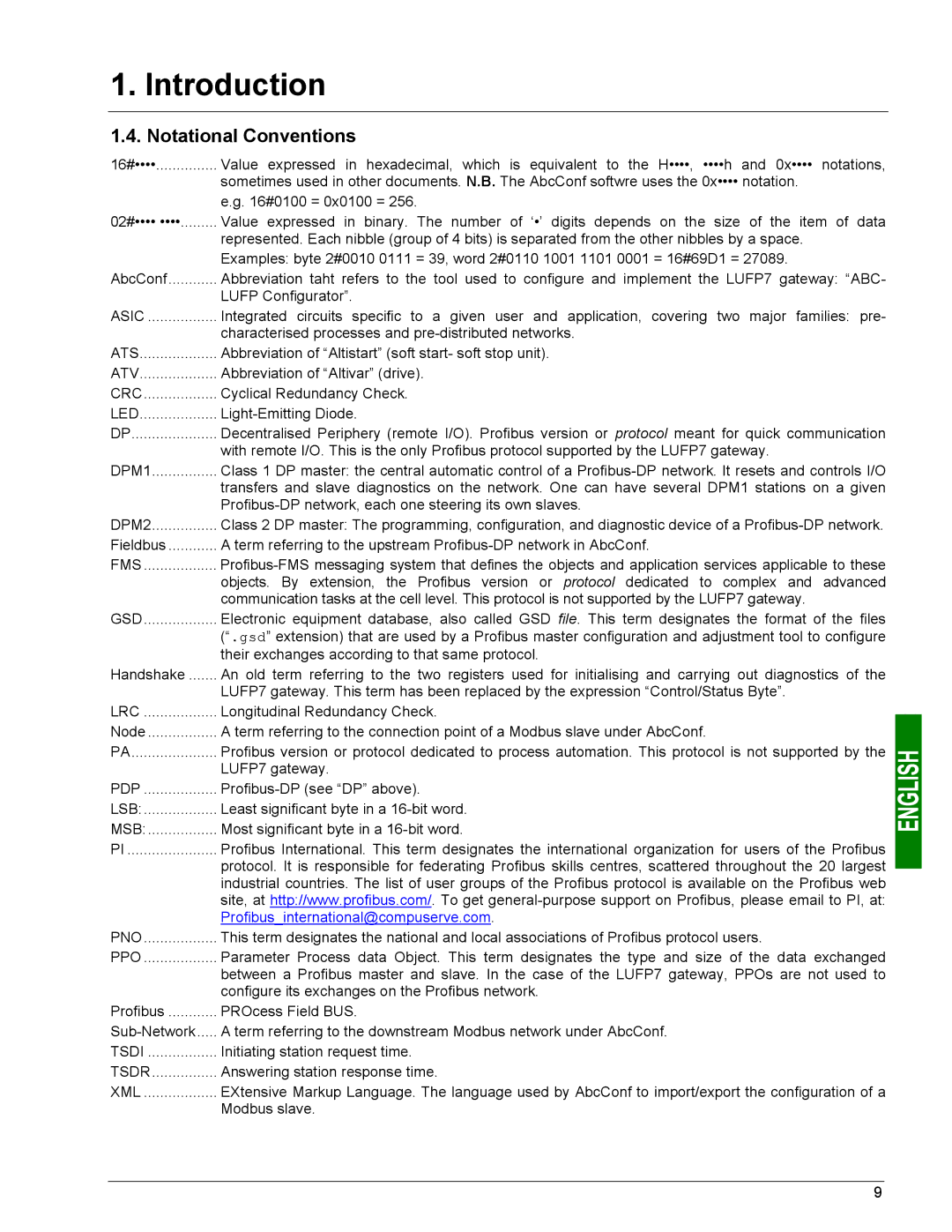
1. Introduction
1.4. Notational Conventions
16#•••• | Value expressed in hexadecimal, which is equivalent to the H••••, ••••h and 0x•••• notations, |
| sometimes used in other documents. N.B. The AbcConf softwre uses the 0x•••• notation. |
| e.g. 16#0100 = 0x0100 = 256. |
02#•••• •••• | Value expressed in binary. The number of ‘•’ digits depends on the size of the item of data |
| represented. Each nibble (group of 4 bits) is separated from the other nibbles by a space. |
| Examples: byte 2#0010 0111 = 39, word 2#0110 1001 1101 0001 = 16#69D1 = 27089. |
AbcConf | Abbreviation taht refers to the tool used to configure and implement the LUFP7 gateway: “ABC- |
| LUFP Configurator”. |
ASIC | Integrated circuits specific to a given user and application, covering two major families: pre- |
| characterised processes and |
ATS | Abbreviation of “Altistart” (soft start- soft stop unit). |
ATV | Abbreviation of “Altivar” (drive). |
CRC | Cyclical Redundancy Check. |
LED | |
DP | Decentralised Periphery (remote I/O). Profibus version or protocol meant for quick communication |
| with remote I/O. This is the only Profibus protocol supported by the LUFP7 gateway. |
DPM1 | Class 1 DP master: the central automatic control of a |
| transfers and slave diagnostics on the network. One can have several DPM1 stations on a given |
|
|
DPM2 | Class 2 DP master: The programming, configuration, and diagnostic device of a |
Fieldbus | A term referring to the upstream |
FMS | |
| objects. By extension, the Profibus version or protocol dedicated to complex and advanced |
| communication tasks at the cell level. This protocol is not supported by the LUFP7 gateway. |
GSD | Electronic equipment database, also called GSD file. This term designates the format of the files |
| (“.gsd” extension) that are used by a Profibus master configuration and adjustment tool to configure |
| their exchanges according to that same protocol. |
Handshake | An old term referring to the two registers used for initialising and carrying out diagnostics of the |
| LUFP7 gateway. This term has been replaced by the expression “Control/Status Byte”. |
LRC | Longitudinal Redundancy Check. |
Node | A term referring to the connection point of a Modbus slave under AbcConf. |
PA | Profibus version or protocol dedicated to process automation. This protocol is not supported by the |
| LUFP7 gateway. |
PDP | |
LSB: | Least significant byte in a |
MSB: | Most significant byte in a |
PI | Profibus International. This term designates the international organization for users of the Profibus |
| protocol. It is responsible for federating Profibus skills centres, scattered throughout the 20 largest |
| industrial countries. The list of user groups of the Profibus protocol is available on the Profibus web |
| site, at http://www.profibus.com/. To get |
| Profibus_international@compuserve.com. |
PNO | This term designates the national and local associations of Profibus protocol users. |
PPO | Parameter Process data Object. This term designates the type and size of the data exchanged |
| between a Profibus master and slave. In the case of the LUFP7 gateway, PPOs are not used to |
| configure its exchanges on the Profibus network. |
Profibus | PROcess Field BUS. |
A term referring to the downstream Modbus network under AbcConf. | |
TSDI | Initiating station request time. |
TSDR | Answering station response time. |
XML | EXtensive Markup Language. The language used by AbcConf to import/export the configuration of a |
| Modbus slave. |
9
